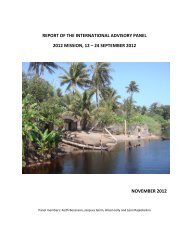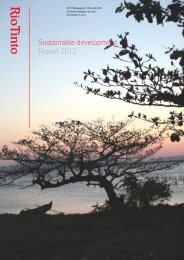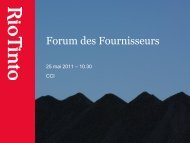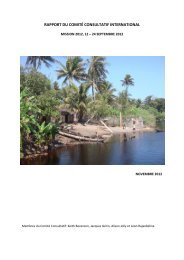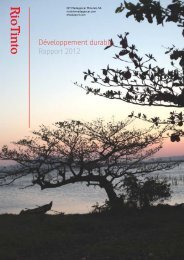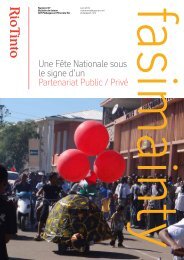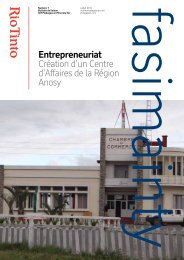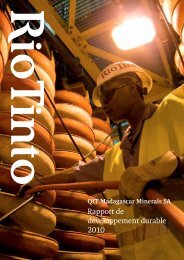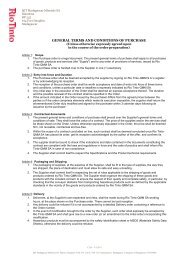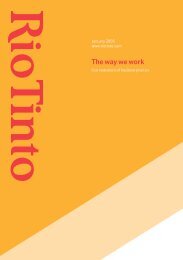Tracking Development - Rio Tinto - Qit Madagascar Minerals
Tracking Development - Rio Tinto - Qit Madagascar Minerals
Tracking Development - Rio Tinto - Qit Madagascar Minerals
Create successful ePaper yourself
Turn your PDF publications into a flip-book with our unique Google optimized e-Paper software.
executive summary<br />
Recognising the shortcomings of local educational facilities,<br />
QMM has funded the construction and rehabilitation of public<br />
schools in its neighbour communities. Offering scholarships<br />
and financing literacy programmes, many who never had the<br />
possibility to attend or complete school are being given a<br />
chance. To build people’s capacity so everyone has an equal<br />
opportunity to be involved in the project, a first-of-its-kind<br />
vocational and technical training centre was opened in<br />
2007. For students who wish to apply their studies through<br />
practical training, an apprenticeship programme commenced<br />
at Mandena in 2010. QMM invests in its employees and<br />
numerous technical and leadership trainings have taken place<br />
internally and externally, within the region, across <strong>Madagascar</strong><br />
and abroad. (See The Production Phase, Encouraging<br />
Educational Opportunities, p. 38-41.)<br />
Economic development, through the recruitment of local<br />
personnel, the construction of new infrastructure or the local<br />
procurement of goods and services, is essential for the Anosy<br />
region. QMM has adopted a hiring process intended to grant<br />
preference to local applicants. Over 90 per cent of current<br />
employees are Malagasy. In 2011, of the 652 total direct<br />
hires, 70 per cent were recruited from the region. For those<br />
who do not have a particular skill set or qualification, HIMO<br />
projects (Haute Intensité de Main d’Oeuvre or High Intensity<br />
Labour Projects) are being carried out, generating hundreds<br />
of jobs. To enable local businesses to continually develop<br />
technical and managerial skills, QMM participates in various<br />
support and capacity building sessions. As one of the primary<br />
obstacles to local participation in economic opportunities<br />
was the absence of microfinance, in 2007 the region’s first<br />
microfinance institution was established. In April 2010, QMM<br />
transferred its original 50 shares from the institution to three<br />
farmers’ associations for future development. Infrastructure,<br />
most notably the Port of Ehoala, but also roads, electricity and<br />
a potable water treatment plant, have been constructed and<br />
are operational. Access to this infrastructure is shared with<br />
the public. Situated as the principal structure for economic<br />
development in the region, <strong>Madagascar</strong>’s second largest<br />
port, the Port of Ehoala, offers opportunities for agricultural<br />
production and business development, while acting as a<br />
catalyst for investment in the region and country as a whole.<br />
(See The Production Phase, Maximising the Economic<br />
Impact, p. 42-45.)<br />
Sustainable development is a cornerstone of QMM’s<br />
approach to business. The company is committed to<br />
supporting activities that contribute to more prosperous<br />
communities. To improve local living standards and enhance<br />
livelihoods, QMM launched two flagship programmes<br />
with annual budgets totalling over US$1.5 million.<br />
The Programme de Développement Intégré (PDI, or<br />
Integrated <strong>Development</strong> Programme), managed jointly<br />
with government representatives, promotes incomegenerating<br />
activities, alleviating pressure on natural resources<br />
and improving income-levels of the population residing<br />
around mining and mining-related activities. Over 2,000<br />
participants across 33 villages in the rural communities<br />
bordering Mandena are currently involved in 17 projects<br />
including animal husbandry, vegetable cultivation, fisheries<br />
and handicraft production. The Fagneva programme, a fiveyear<br />
community plan with interventions in Fort Dauphin<br />
and its immediate surroundings, was launched in 2010.<br />
This collaborative effort with government representatives,<br />
community representatives, the private sector, NGOs<br />
(non-governmental organisations) and QMM includes six<br />
projects targeting governance, sports and culture, education,<br />
security, sanitation and economic development. (See The<br />
Production Phase, Ensuring Sustainable <strong>Development</strong>,<br />
p. 46-53.)<br />
8



